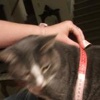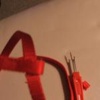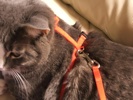Last night, I made a cat harness for my big boy, Alladin.

We’ve been training Alladin, and are about to start on the leash-walking. Unfortunately, this requires a harness and leash. Doubly unfortunately, nearly every cat harness I’ve seen is too small.
There are two basic harness styles: H style and figure 8. The figure-8 harness is adjustable and the one we have is both harness and leash, so it’s actually adjustable to the right size (as long as we don’t mind having a slightly shorter leash). However, for various reasons, I’m not wild about this harness/leash combo, so I wanted an H-style.
The H-style harness has two loops, attached to a strap on the back. Some also have a front strap, but that’s usually for dogs. For cats, the straps are made of 3/8″ wide nylon webbing, which is about the thinnest you’ll find, and light enough for a cat to wear comfortably. The harness I bought for Alladin was 3/8″ wide webbing, and the front loop fit fine, but the back…. well, let me show you with a little picture story:
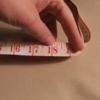
His girth behind the front legs is 18″
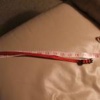
Fully expanded, the back loop of the commercial harness is 17″ long.
If I allow for even a little wiggle room, the commercial harness is about an inch and a half too small. Now, I’m a plus-sized girl myself, so I know how cranky it makes me to wear something too tight. The whole thing about training a cat to walk on leash is that they must not feel uncomfortable or anxious in doing so.
So, a couple of weeks ago I ordered a couple of yards of 3/8″ webbing and some red polyester thread from Seattle Fabrics. It arrived yesterday, and I set about resizing the commercial harness into one that would fit.
First, I took a deep breath and resigned myself to cutting and destroying the commercially-made harness. This was not easy to do– what if I screwed it up?
Then, I took a good, long look at the construction of the thing. I took special note of all the places where the webbing goes through something, because once it ‘s been sewn, the chances are it’s not going back through that thing again.
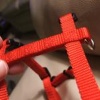
The rear loop strap goes through the “H” strap down the back, and is sewn in place. Since I didn’t want to cut and replace the whole back strap, this was the one place where I used a seam-ripper:
Ripped out the stitches holding the rear loop in the H strap.
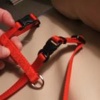
Pay careful attention to where the straps attach to the buckles, and how.
I should have drawn a diagram, but instead I kept it all in my head as I worked. This project took about an hour and a half, and I did it all in one sitting. If I’d had to stop and pick it back up again, I would have needed a drawing or some way to remember what went where.
One way that I remembered was, as soon as I removed a strap from a buckle or fitting, I replaced it with the new, longer strap, and safety-pinned the strap in place:
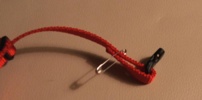
Safety-pin all straps as you go.
I quickly realized that the best flow would be to start with the more complicated strap (the one with the adjuster), and just work the strap into all the places it needed to go. Of course, I realized this quickly after I’d already started from the wrong direction, and made it harder for myself.
In any case, if i were to do this again, here’s how I’d do it:
- Attach one end to the adjuster and sew it in place. I have a sewing machine, but I did this by hand, because the webbing is so narrow and it’s very thick– I’d have wanted a heavy duty needle, if not an industrial sewing machine, for the job. I recommend using a thimble if you hand-sew.
- Take the free end of the webbing and threaded it through the slide locker (the tiny narrow thing that helps lock in the adjustment), then the male end of the buckle, then back through the adjuster slide. At this point, that end of the strap is done.
- Slide the rest of the strap through the hole in the H-strap left when you seam-ripped out the old strap.
- Slide it through the female end and fold over about an inch.
- Make sure that the male and female ends connect without twisting the strap (it seems like a duh thing, but this would be the kind of duh mistake I would make).
- Stitch the female end.
- Slide the female end as close to the H strap as possible, to match the neck loop. Make sure it’s straight in place.
- Stitch through the H strap to attach the rear loop strap.
Try it on the cat, adjusting the loop straps to fit!
